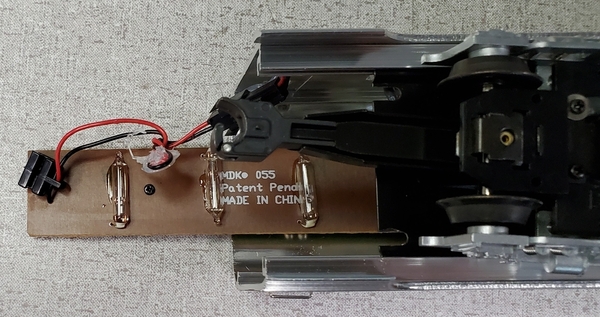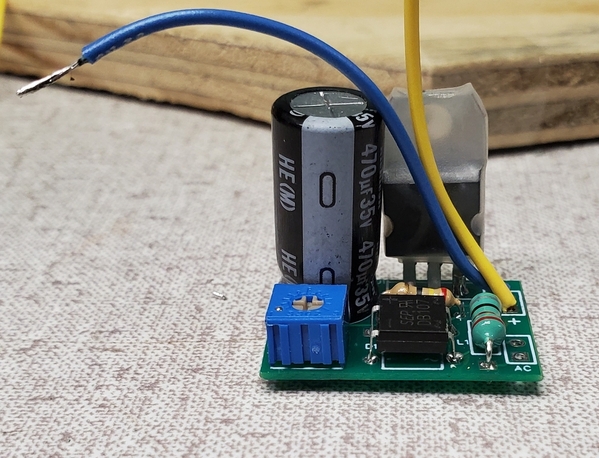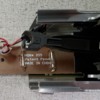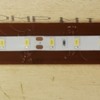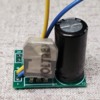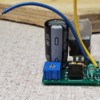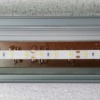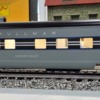The fine K-Line 46xx series extruded-aluminum, streamlined passenger cars present easy LED strip conversion opportunities, with minimal disassembly required. This post is written for the “general” car situation. RPOs and observations have specific considerations which will be addressed in separate posts. The cars depicted herein are the 18” versions. The 21” and 15” renditions should be conceptually similar.
These cars include a rib down the centerline of the interior ceiling, from which the Streamline circuit board is supported via plastic U-brackets attached to its copper side. This allows the entire Streamlighting board to be extracted from the car after an end piece is removed. The LED strip physically replaces the bulbs and the board is easily reinstalled in the car. The entire conversion operation can take as little as 30 minutes, assuming LED strip and constant-current regulator pre-wired and ready for installation.
The first step is to remove the car end where the wires from the Streamlighting circuit board are located. This is usually the end of the car which does not have a vestibule, though production variations exist. The car end is attached to the ceiling rib by a molded-in U-bracket and held in place at its bottom by screws entering it from the car's base plate. The two screws that attach the car's floor plate to the plastic end piece are removed, which frees up the end piece for extraction.
Next, the track power wire glue is loosened and the plug-and-socket connection between the truck power feeders and the Streamlighting board is opened. This permits the Streamlighting board to be extracted from the car by pulling it out of the open end, as shown below.
It's not unusual for passenger figures to come unglued inside the car. This point in the process is where the car floor plate and interior is most easily removed to re-glue the figures in place and attend to any other interior detailing desired. The undercarriage detail piece and the two screws at the unopened end of the car need to be removed first. Hot glue seems to work well to hold loose “people” in place. The floor plate should be reinstalled before moving forward with the following steps.
To prepare the Streamlighting board for reuse, the bulbs and track power connection wires are removed from the board. Note that these need not be de-soldered; they can be clipped off, as board's circuit traces are not reused. The board merely provides a surface for attachment of the LED strip. Don’t detach the U-brackets from the copper side of the Streamlighting board. Most Streamlighting boards have pliable adhesive holding the lamps in place, but some have hard glue. In the latter case, the glue should be removed using a sharp knife before the LED strip is attached.
It is best if LED strip and track power wires (the latter previously disconnected from those attached to the car base plate) are connected to the constant-current regulator unit prior to attaching the strip to the Streamlighting board, as shown above. Regulator output wires should be 2½-3" in length. A piece of heat-shrinkable tubing should be placed over the regulator IC body, to prevent conduction from the metal back of the IC to the carbody, as it will be placed against the side in some cars.
While the residual adhesive (if pliable) of the incandesent bulbs and the adhesive backing of the LED strip should be sufficient to hold the strip in place atop the board, occasional dollops of hot glue add insurance of attachment integrity. These pictures show 18” cars, which used 7-triplet LED strips. 21” cars will use 8-triplet LED strips, while 15” cars will use 6-triplet strips.
With the LED strip securely in place, the Streamlighting board is reinstalled onto the ceiling rib of the car. It should be pushed in far enough to accommodate the current regulator card's length, at the open end of the car. The track power wiring can now be reconnected at the car end. (Though the car's base plate was removed to take the next photo, that is not normally part of the conversion procedure.)
The constant-current regulator should be attached to the carbody using double-sided foam tape, 1/8" thick. The mounting location will depend on the nature of the car's interior. The regulator should be oriented such that its tabbed IC and large capacitor are placed to facilitate removal of the base plate and interior assembly, to service or modify interior features. For the sleeper, the regulator was mounted to the roof, as shown in the photo below. An additional, narrow strip of double-sided tape was added at the interior side of the regulator to compensate for roof curvature. The outer edge of the card should be recessed about 1/8" from the edge of the car extrusion, to accomodate a locating tab on the car end piece.
Before replacing the car end piece, the regulator should be set to draw appropriate AC current from the track, at a voltage of 16-18 VAC. Ensure that the track power from the car’s base plate is connected to the wire leading to the regulator input. Connect a variable transformer output to the center rail pickup and a wheel axle, with a multimeter inserted in one of those leads. Raise AC voltage into the desired 16-18V range. Then adjust the regulator's pot to achieve the desired track current. With 7-triplet LED strips, 35 mA provides very good, but not excessive, illumination. 8-triplet strips would be set to 40 mA and 6-triplet strips set to 30 mA. (A DC power supply can also be used, using the same voltage and setting current draw to the same 35 mA.) If 35 mA seems too bright, then try 25 mA (30 mA and 21 mA for longer or shorter cars).
Here's a completed sleeper:




